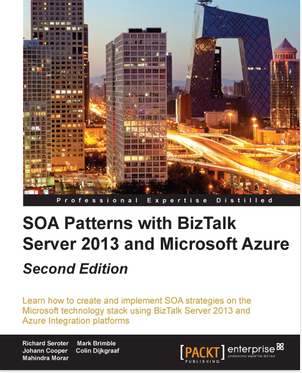Disclaimer – Shameless (but hopefully informational) plug follows 🙂
Close to a year ago myself and my colleagues Mark, Mahindra, and Colin were approached by Packt Publishing to update Richard Seroter’s “SOA Patterns with BizTalk Server 2009” book for BizTalk Server 2013. We considered this a great honour seeing as the base material in the first edition was so good, and decided to take on the project.
Nine months of working through the authoring process later, I am pleased to announce that “SOA Patterns with BizTalk Server 2013 and Microsoft Azure – Second Edition” is due to be published imminently and is available for pre-order.
So what will you find in this edition of the book?
For me personally, the first edition of this book made me realize that there if more to BizTalk than tightly bound orchestrations, and it opened my eyes to how the platform could be used to maximum effectiveness. It is my personal favourite BizTalk book, and it is one of only two BizTalk books that I personally own and have read cover to cover many times (the other is Professional BizTalk Server 2006). I’ve of course read loads more BizTalk books, but these are ones I want in my personal library at home.
Given this high degree of respect for the first edition, you’ll find that much of it has been preserved in its original form. What you will find is that some of the original material has been tweaked to make it more relevant, and that it has been interspersed with many more warnings, tips, and tricks.
Beyond the original source material, we now have major portions of the book dedicated to Azure platforms such as Service Bus, and MABS (Microsoft Azure BizTalk Server). We also explore the usage of Azure App Services’ API Apps and Logic Apps, as well as Azure API Management however this is more of a peek under the covers to whet your whistle rather than an extreme deep dive.
We also dive deep into the use of REST and how to implement RESTFul APIs using BizTalk Server. Expect to get into the theory behind REST as well as read about some practical examples. Given how relevant RESTFul APIs are in the integration space these days this is something which all BizTalkers should be exposed to.
We have an entire chapter that is dedicated to introducing you to tools that we believe that you should be aware of, and should be carefully assessing for usage in your own environment. These include the ESB Toolkit, the BRE Pipeline Framework, Sentinet, BizTalk 360, AIMS for BizTalk, and the BizTalk Documenter. While there are way more frameworks we’d have loved to discuss, there was simply limited space so we had to prioritize. We have provided quick summaries of those that we feel need awareness but weren’t in our top pick (due to relevance to the book’s title rather than due to how functional and generally useful they are).
As BizTalk Server 2013 R2 was released after we started working on the book and the number of new features that are applicable to this book are relatively limited, we decided to truck on and focus on BizTalk Server 2013. However, we would be negligent not to mention those features in BizTalk Server 2013 R2 that are relevant to this book, so you will find a section on BizTalk Server 2013 R2 in the book as well.
Finally, you will find that we have updated the existing accompanying source code for BizTalk Server 2013 and expanded the existing samples with further examples (for example we demonstrate in brief how the async features in .NET 4.5 can be used in WCF clients, and we have also provided samples for untyped orchestrations). And of course we have added brand new source code to accompany new chapters as well.
It has been a great honour writing this book, and it will be an even greater honour if you decide to read it as well. I sincerely hope that we have done Richard’s original book justice, and that this new edition helps to add to your knowledge, expand your horizons, and further your careers.



Reblogged this on Connected Pawns.
LikeLike
Reblogged this on BizTalk musings.
LikeLike
Well done Johann!
The 2009 version is a bible for BizTalkers, and this update seems to be a definite “must-have” to a BizTalkers library.
I will spread the word also, but I do suggest some “give-aways” of the book through User Groups and the like!
Congrats!
LikeLike
Hi John,
Thanks for that. I agree, and we are doing a give away of some of our extra personal copies for an upcoming event in NZ. I’ll have a word with our publisher if we can sort out some more give aways for events in other locations.
Cheers
Johann
LikeLike
Hi John, is there a user group that you are part of? Can you provide me with any details on it so I can organise freebies? Who is the leader and how many members do you have?
LikeLike
Hi Johann,
The ideal user group for your book would be the Sydney Connected Systems User Group run by Mick Badran. The last meeting was in Feb 2012. I spoke to him back in late July 2014 (at the BizTalk Summit… if you can remember that lol!) to resurrect it with him but unfortunately nothing has happened.
These days I’m more heavily into Azure and attend the very active 700+ member Azure Sydney User Group on occasion. It is run by Simon Waight. I’ll see if he is interested….
And thanks for offering the book! As I would testament (based on the 2009 edition), it is a must-have BizTalk book!
LikeLike
Great job, and I’m sure you’ve improved on the original!
LikeLike
Looking forward for the 2nd edition of one of my all time favorite BizTalk book 🙂
LikeLike
Thanks Gautum, I hope you enjoy reading it.
LikeLike